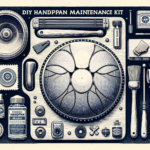Introduction
The handpan is a beautiful and mystical musical instrument known for its ethereal sound, and its tuning plays a fundamental role in ensuring that the tones produced are harmonious and pleasing to the ear. Proper tuning techniques are essential for maintaining the unique timbre and acoustic qualities of the handpan. In this article, we will delve into the various handpan tuning techniques that artisans and musicians use to ensure optimal sound quality.
Understanding the Handpan Structure
Before diving into tuning techniques, it is crucial to understand the basic structure of a handpan. Handpans are composed of two convex steel shells – a top shell (which has the note fields) and a bottom shell with a hole in the center, known as a Gu hole. The top shell features indentations called tone fields, each emitting a different note when struck. The tuning process involves meticulous adjustments to these tone fields to achieve the desired sound.
Tuning Techniques
1. Hammer Tuning
The most common method of tuning a handpan involves the use of specialized tuning hammers. This technique requires a great deal of skill and precision. Here’s a step-by-step guide on how it is done:
- Identifying the note: The tuner begins by identifying the correct pitch for each tone field. This often involves using a tuning software or a tuning fork.
- Application of force: The tuner uses a small hammer to gently tap around the tone field, making micro-adjustments to the metal’s shape. These adjustments change the tension and stiffness of the area, thereby altering its pitch.
- Frequency testing: After each tap, the tuner strikes the tone field and measures the frequency to ensure it matches the desired pitch. This step is repeated until the exact frequency is achieved.
2. Electronic Tuning Devices
With advancements in technology, electronic tuning devices have become more prevalent. These devices can help achieve precise tuning more efficiently. Here’s how electronic tuning devices are used:
- Analyzing the sound: The electronic tuner analyzes the sound of the tone field and displays the current pitch.
- Guided adjustments: Based on the display, the tuner makes necessary adjustments to either increase or decrease the pitch. This often involves using traditional hammer techniques but with the added accuracy of electronic measurement.
3. Laser-Assisted Tuning
Laser-assisted tuning is an advanced method that incorporates laser technology to measure the vibrations of the handpan. This technique is known for its precision and consistency:
- Vibration analysis: A laser device is used to analyze the vibrations of each tone field when struck. This provides an accurate measurement of the current pitch and its deviations from the intended pitch.
- Adjustments and fine-tuning: Based on the laser measurements, adjustments are made to the tone fields using traditional hammer techniques until the vibrations match the desired pitch.
4. Physics-Based Tuning Models
Some tuners use physics-based models to predict the necessary adjustments to achieve a specific pitch. This technique involves complex calculations and simulations:
- Theoretical calculations: Tuners use mathematical models to calculate the necessary changes in tension and stiffness required to reach a specific pitch.
- Applying adjustments: Based on these calculations, the tuner makes precise adjustments using traditional hammering methods.
Factors Affecting Handpan Tuning
Several factors can affect the tuning of a handpan. Understanding these factors is crucial for maintaining optimal sound quality:
1. Material Quality
The quality of the material used in making the handpan significantly affects its tuning. High-quality steel provides better resonance and stability, allowing for more precise tuning.
2. Environmental Conditions
Environmental factors such as temperature and humidity can impact the tuning of a handpan. Changes in temperature cause the steel to expand or contract, affecting the tension of the tone fields. Humidity can also cause rust, which can alter the instrument’s sound.
3. Playing Style
The way a handpan is played can also impact its tuning. Striking the instrument too hard or in the wrong locations can cause it to go out of tune. Proper playing technique helps maintain the instrument’s tuning for a longer period.
4. Wear and Tear
Over time, the handpan’s tone fields can wear out, causing it to go out of tune. Regular maintenance and careful playing can extend the lifespan of the instrument’s tuning.
Conclusion
Handpan tuning is both an art and a science, requiring a deep understanding of the instrument’s structure, material properties, and the physics of sound. Skilled tuners utilize various techniques, from traditional hammer tuning to advanced electronic methods, to ensure that each handpan produces its distinctive, enchanting sound. By understanding and addressing the factors that affect tuning, players and tuners can maintain the optimal sound quality and longevity of this beautiful instrument. Whether you are a musician or a handpan enthusiast, appreciating the intricacies of handpan tuning enhances the overall experience of playing and listening to this unique instrument.
FAQs
1. How often should I tune my handpan?
The frequency of tuning depends on how often and how hard you play your handpan. Generally, handpans may need tuning every 1-2 years, but regular maintenance checks are advisable.
2. Can I tune my handpan myself?
Tuning a handpan requires specialized skills and equipment; it is usually recommended to have it done by a professional tuner to avoid damaging the instrument.
3. What should I do if my handpan goes out of tune?
If your handpan goes out of tune, it’s best to consult a professional tuner. Avoid attempting to fix it yourself if you are not experienced, as this could cause further damage.
4. How does temperature affect handpan tuning?
Temperature changes cause the steel to expand or contract, which can alter the tension of the tone fields and affect the tuning. It’s important to store the handpan in a stable environment.
5. Are electronic tuners more accurate than traditional methods?
Electronic tuners can provide greater accuracy and efficiency in measuring pitch, but the skill and experience of the tuner are still crucial for making the necessary adjustments.





